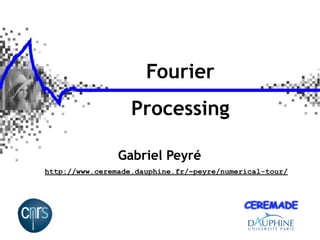
Signal Processing Course : Fourier
- 1. Fourier Processing Gabriel Peyré http://www.ceremade.dauphine.fr/~peyre/numerical-tour/
- 2. Overview • Continuous Fourier Basis • Discrete Fourier Basis • Sampling • 2D Fourier Basis • Fourier Approximation
- 3. Continuous Fourier Bases Continuous Fourier basis: m (x) = em (x) = e2i mx
- 4. Continuous Fourier Bases Continuous Fourier basis: m (x) = em (x) = e2i mx
- 6. Fourier and Convolution f ∗1[ − 1 , 1 ] 2 2 f x− 1 2 x x+ 1 2
- 7. Fourier and Convolution f ∗1[ − 1 , 1 ] 2 2 f x− 1 2 x x+ 1 2 1 0.8 0.6 0.4 0.2 0 1 0.8 0.6 0.4 0.2 0 1 0.8 0.6 0.4 0.2 0
- 8. Fourier and Convolution f ∗1[ − 1 , 1 ] 2 2 f x− 1 2 x x+ 1 2 1 0.8 0.6 0.4 0.2 0 1 0.8 0.6 0.4 0.2 0 1 0.8 0.6 0.4 0.2 0
- 9. Overview • Continuous Fourier Basis • Discrete Fourier Basis • Sampling • 2D Fourier Basis • Fourier Approximation
- 12. Discrete Fourier Transform ˆ ˆ g [m] = f [m] · h[m] ˆ
- 13. Discrete Fourier Transform ˆ ˆ g [m] = f [m] · h[m] ˆ
- 14. Overview • Continuous Fourier Basis • Discrete Fourier Basis • Sampling • 2D Fourier Basis • Fourier Approximation
- 15. The Four Settings Note: for Fourier, bounded periodic. Infinite continuous domains: f0 (t), t R ... ... +⇥ ˆ f0 ( ) = f0 (t)e i t dt ⇥ Periodic continuous domains: f0 (t), t ⇥ [0, 1] R/Z 1 ˆ f0 [m] = f0 (t)e 2i mt dt 0 Infinite discrete domains: f [n], n Z ... ... ˆ f( ) = f [n]ei n n Z Periodic discrete domains: f [n], n ⇤ {0, . . . , N 1} ⇥ Z/N Z N 1 ˆ f [m] = f [n]e 2i N mn n=0
- 16. Fourier Transforms Periodization f0 (t) ⇥ n f0 (t + n) f [n] = f0 (n/N ) Sampling f0 (t), t R f0 (t), t [0, 1] Continuous f [n], n Z f [n], 0 n<N Discrete Fourier transform Isometry f ⇥ f ˆ Infinite Periodic f0 (N (⇥ + 2k )) ˆ Sampling f0 ( ) ⇥ ˆ {f0 (k)}k ˆ f0 ( ), ˆ f0 [k], k Z Infinite Periodization R ˆ ˆ ˆ f (⇥), ⇥ [0, 2 ] f [k], 0 k<N Periodic k f (⇥) = Continuous Discrete ˆ +⇥ 1 ˆ f0 ( ) = f0 (t)e i t dt ˆ f0 [m] = f0 (t)e 2i mt dt ⇥ 0 N 1 ˆ f( ) = f [n]e i n ˆ f [m] = f [n]e 2i N mn n Z n=0
- 17. Sampling and Periodization (a) (b) 1 (c) 0 (d)
- 18. Sampling and Periodization: Aliasing (a) (b) 1 (c) 0 (d)
- 19. Uniform Sampling and Smoothness
- 20. Uniform Sampling and Smoothness
- 21. Uniform Sampling and Smoothness
- 22. Uniform Sampling and Smoothness
- 23. Overview • Continuous Fourier Basis • Discrete Fourier Basis • Sampling • 2D Fourier Basis • Fourier Approximation
- 24. 2D Fourier Basis 1 2i m1 n1 + 2i m2 n2 em [n] = e N0 N0 = em1 [n1 ]em2 [n2 ] N
- 25. 2D Fourier Basis 1 2i m1 n1 + 2i m2 n2 em [n] = e N0 N0 = em1 [n1 ]em2 [n2 ] N
- 26. Overview • Continuous Fourier Basis • Discrete Fourier Basis • Sampling • 2D Fourier Basis • Fourier Approximation
- 28. 1D Fourier Approximation 1 1 0.8 0.8 0.6 0.6 0.4 0.4 0.2 0.2 0 0 1 1 0.8 0.8 0.6 0.6 0.4 0.4 0.2 0.2 0 0
